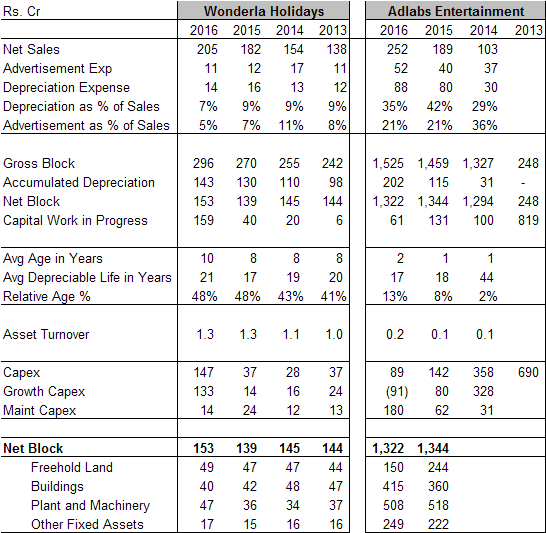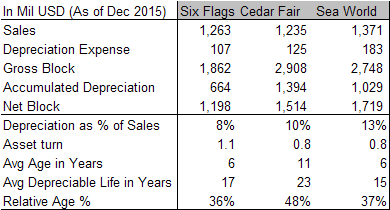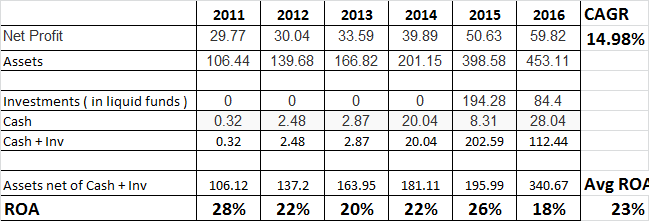Hi Kumar,
Thanks for sharing your model. It’s really comprehensive and covers a lot of future projections.as you said it is quiet different from the one I use which is more of a top-down one-size-fits-all kind of model. Your model is a bottom up model where you calculate numbers from the ground up. However, I think in such a model you should project key numbers like sales, profits, net worth, debt besides cashflows and ratios like growth, margins and ROE to to make sure that these numbers are consistent with peers and company’s own past. e,g, if your projections result in a ROE of 35% or a growth rate of 40%, then there should be some justification for these numbers.
Another consistency check to add is terminal price multiples. e.g. terminal PE or PS. This will ensure that exit multiples are in line with averages for similar businesses and valuation model does not assume multiple expansion (or contraction) that is unsustainable.
In my model, I use the exact same approach. I start with the assumption that any business will have a limited ROE which is likely to revert to an average which in turn will be close to nominal GDP growth rate. Hence I normally assume that in the long term strong businesses will generate an ROE of 15-20% in perpetuity while average businesses will generate ROE of 12-15%. In the short term, emerging businesses like Wonderla can and do generate high to very high ROE but that will fall. It’s not possible to say how but it’s not a question of how or if but rather when. A business like Wonderla will generate a good ROE for a long time but I am being conservative in my model as I do not think Wonderla will able to replicate it’s past high profitability in future parks. It’s future parks will have good profitability but not high profitability.
Another assumption is about terminal growth rate and growth opportunities. You have used 2% which I think is too low. It should be close to 7-8%. let me explain. A business cannot just keep growing forever. Wonderla cannot just keep adding parks in perpetuity. At some point they are going to saturate the market or lose their mojo. Whether it is in 10 years or 50 years is anyone’s guess. They can get into some other line of business but that cannot be assumed in advance. In mature stage, sustainable growth will be slightly less than nominal GDP growth rate (less because a mature business grows at less than average rate while a emerging business grows at above average). Nominal GDP growth rate in 10 or 20 years will less than current rate. since current nominal GDP growth rate is about 12-14%, I am assuming nominal GDP growth rate in 20 years will be 8-10% and growth rate of mature companies will be in the range of 6-10%. For the purpose of valuation, I project dividends and assume company’s dividend payout will be such that sustainable growth rate (ROE * (1-payout ratio)) is close to growth opportunities.
Another way of looking at terminal growth rate is that Wonderla will be able to increase prices 1-2% points higher than inflation and have 2-3% real growth rate in the form of higher footfalls, more parks, ancillary revenues like food and merchandise etc. If you assume inflation (in prices of discretionary items) to be 4% total growth rate works out to be 8% (4% +1.5% + 2.5%)
Next major parameter in the model is discount rate. You have used 9%. I don’t see how you have arrived at this number. Terminal value account for a large % of total value in a DCF model and it is very sensitive to terminal growth rate and discount rate. Even in your model, terminal value account for 40% of total present value. If I use discount rate of 13% and terminal growth rate of 8% I am getting a per share value of Rs 218. Of course I only changed these two numbers in the sheet. I will probably have to change few other numbers as well to get the correct value.
There should be a reasonable basis for deciding discount rate. I use the Capital Asset Pricing Model (CAPM) which adds an equity risk premium to risk free rate to arrive at the discount rate. Equity risk premium for the company is the product of equity risk premium for Indian stocks in general and company beta. Here, I use average beta for consumer discretionary companies (airlines, hotels, auto, retail etc) as beta for Wonderla is too low.
If everything works out as projected, your expected return on your investment is your discount rate. At 9% it is too low for anyone to risk their capital in a volatile business like Wonderla. If you use DCF to extract implied discount rate for mature businesses (ITC, Maruti, TCS HDFC etc), you will notice that discount rate is about 10-11%. I take this as a bare minimum as these companies are stable businesses with proven business models that aren’t going to go out of business anytime soon. their beta is also low at 0.8 to 1 reflecting their low relative risk. Any business that is far away from these conditions will be incrementally risky. Consumer discretionary companies have a beta of 1.2 to 1.6 due to volatile nature of their businesses and stock price. Wonderla fits in this league. Given the execution risk of future parks, I would not use a beta less than 1.4. That gives me a discount rate of 14%.
Another way of looking at discount rate is your opportunity cost. Since your expected return is your discount rate, just ask yourself if you have any other opportunities to earn more that 9% while keeping risks that are the same levels as Wonderla. Discount rate can be considered as the minimum rate of return that you want for you to risk your capital in this business.
By being conservative in my projections I am leaving a possibility that actual results are better than projected so actual returns are better than expected. That’s my margin of safety. Otherwise I am OK with 14%. Mr. Market will make an offer at my intrinsic value about once or twice a year.
Overall, I think your model is excellent in bottom up analysis and arriving at the projections for next few years based on the visibility. I will appreciate if you can just give me your projections for net worth, ROE and profits numbers for next 3-5 years so I can plug it in my model to see if I can close the valuation gap.



